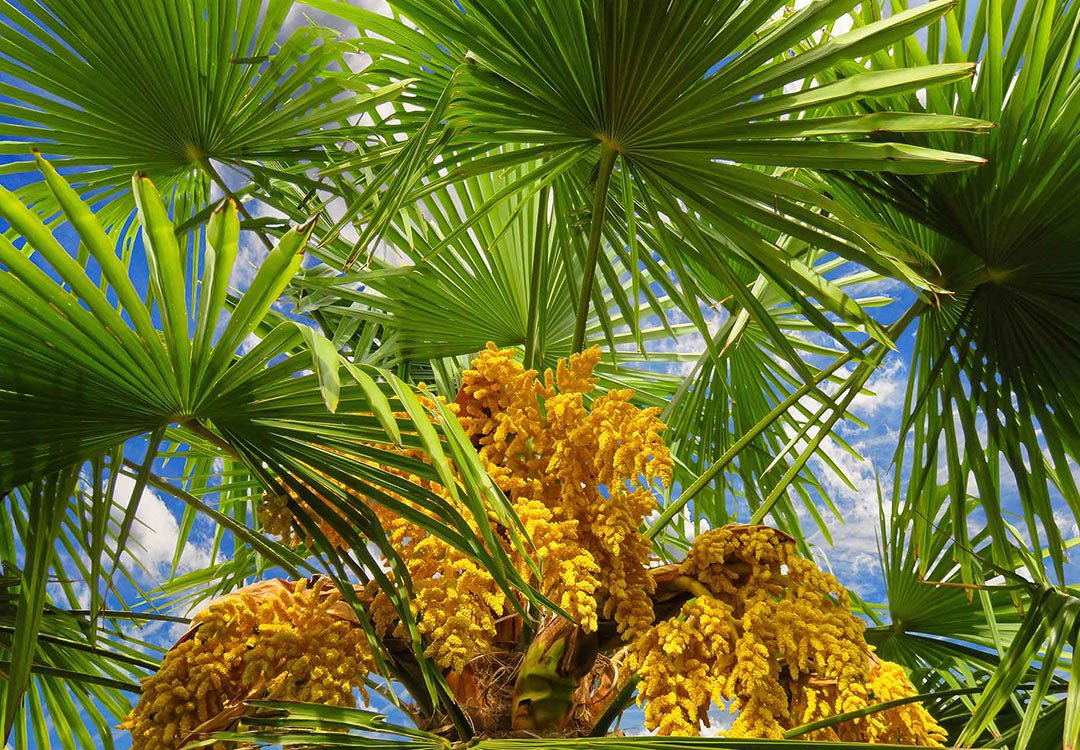
Palms are a family consisting of evergreen monocotyledonous trees, shrubs and climbers with characteristic compound leaves known as fronds.
Even though they do not resemble other trees in the dicot and gymnosperm classes in the way those plants display true secondary (lateral) growth, palms sometimes display “anomalous secondary growth” where individual cells enlarge to thicken the trunk without a vascular cambium.
They tend to do their best in tropical and subtropical regions, however they’re found in a range of climates. Some species even do well in cooler climates.
Some palms may have vicious spikes along the petiole that can break the skin and cause infection (or blindness). A horrifying fact is that the Khmer Rouge used certain spiky palm fronds to kill victims of their regime at the “killing fields” because they were a cheaper way to kill people than using bullets. (I do recommend visiting one of the memorials over there if you get the chance. as a life experience)
Description
Their habit is generally as a rosette of fronds growing in a spiral formation on top of a tall, branchless stem.
When a number of stems form as a cluster at a common base, they can be termed “clustered”. When the plant grows a lone stem, it can be termed “solitary”, as in the case of palm trees.
They are generally monoecious or dioecious with female flowers being larger than male flowers within the same inflorescence when both genders are on the same plant. The inflorescence is branched along a main axis, sometimes branches have branches and so can be called a panicle, or compound raceme.

Golden cane palms Dypsis lutescens with a cluster of stems at a common base. Image source

Solitarty native Australian Alexandra palms Archontophoenix alexandrae doing a good job of bracing against the wind. You can see the leaf sheathing and compound inflorescence structure here. Image source

An unknown palm tree in full bloom. The flowers here are housed on a compound branching inflorescence structure. Image source
Flowers, Fruits & Leaves
Sepals: 3 joined or overlapping sepals.
Petals: From 2 to 10 coloured petals.
Reproductive: 6 stamens, and female parts usually coming in threes.
Fruit: Usually a fibrous fruit surrounds the nut, such as coconut husks and dates in a bunch due to flowers growing in an inflorescence.
Seeds: Coming in different shapes and sizes, from large and globular like a coconut to small and oblong like a date.
Leaves: Palms are recognisable by their (usually) large, parallel-veined pinnately or palmately compound leaves which are called fronds, which are genarally sheathed.
Noteworthy Types
Coconut trees (Cocos spp.) are the first palms that come to mind when we think of palms that we cultivate for food. The fruit is a drupe with the outer layer of the husk to the outer layer of the coconut shell being the fruit, and the inner layer of the shell being the seed coat. These palms are monecious, with plants that have separate male and female flowers on the same plant.

Coconuts hanging from a Coco sp. Image source
Dates Phoenix dactylifera are another cultivated palm where we eat the fibrous fruit around the nut, instead of the nut itself. They can take up to a decade from sprouting to the time they’re able to produce commercially viable yields. These plants are diecious, with separate male and female plants. Male plants never produce fruit but are required to fertilise females.

Female date palm plant Phoenix dactylifera with heavy fruits. Image source
There is a genus of palms Calamus native to the tropical rainforests of Queensland and northern New South Wales that grows as a vine. They are colloquially known as “wait a while”, because when their barbs catch your shirt or backpack during a hike through the rainforest, you have to be calm and wait a while as you detach each individual barb, avoiding pricking any skin or becoming entangled further.

Wait a while Calamus muelleri with its vicious barbs, native to the rainforests of southern QLD and northern NSW, where an unfair number of plants and animals are equipped to do us harm. Image source
Conclusion
There’s simply no mistaking a member of this family; they are unique among plants. Other monocotoledonous tree-like plants with fronds that are not related to this family, such as bananas and birds of paradise, lack the signature compound leaf structure that palms have so can be distinguished.
If you haven’t already read my articles on plant identification and scientific names, I recommend reading those to get a broader picture of the topic. Alternatively, you can browse some of my other plant families, subfamilies and genera below.
